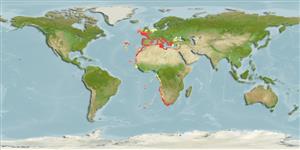Common names from other countries
Environment: milieu / climate zone / depth range / distribution range
Οικολογία
; εύρος βάθους 3 - 871 m (Ref. 78235), usually 50 - 450 m (Ref. 8). Subtropical; 58°N - 41°S, 35°W - 38°E
Eastern Atlantic and the Mediterranean: from Ireland to Senegal, including the Azores and Canary Islands, and the entire Mediterranean. Temperate to tropical.
Length at first maturity / Μέγεθος / Βάρος / Age
Maturity: Lm ? range ? - ? cm Max length : 11.2 cm TL αρσενικό/απροσδιόριστο; (Ref. 8)
Known from pelagic depths between 100 to 200 m (Ref. 92299). Occurs on muddy and sandy bottoms on the shelf and upper slope. Buries in the mud during the day and emerges at night (Ref. 80202). Feeds on benthic invertebrates living on soft bottom substrates like polychaetes, bivalves, gastropods and echinoderms (Ref. 106588).
Life cycle and mating behavior
Γεννητική Ωρίμανση | Αναπαραγωγή | Γεννοβολία | Αβγά | Γονιμότητα | Προνύμφες
Members of the order Decapoda are mostly gonochoric. Mating behavior: Precopulatory courtship ritual is common (through olfactory and tactile cues); usually indirect sperm transfer.
Holthuis, L.B. 1980. (Ref. 8)
IUCN Red List Status (Ref. 130435)
CITES status (Ref. 108899)
Not Evaluated
Not Evaluated
Human uses
αλιεία: περιορισμένης εμπορικότητας
| FishSource |
Εργαλεία
Διαδικτυακές πηγές
Estimates based on models
Preferred temperature
(Ref.
115969): 9.8 - 17, mean 13.7 (based on 593 cells).
Ελαστικότητα
Υψηλό, ελάχιστος χρόνος για διπλασιασμό πληθυσμού < 15 μήνες (K=0.5-0.65).
Vulnerability
Low vulnerability (10 of 100).
Price category
Unknown.
